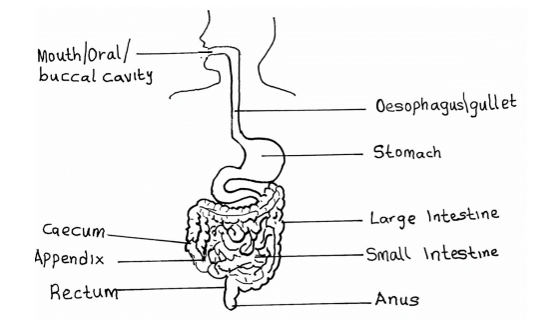Question 2
(a) Explain briefly what happens to a meal that contains fat only as it passes through
the following structures in humans:
(i) mouth; [2 marks]
(ii) duodenum. [3 marks]
(b) Make a diagram, 8 cm to 10 cm long of the alimentary canal in humans and the
label fully. [10 marks]
(c) (i) What is peristalsis, as it relates to digestion? [2 marks]
(ii) Name three glands that facilitates digestion in humans. [3 marks]
Observation
Many candidates did not answer this question, probably because of the drawing of the alimentary canal of humans. Those who attempted the question had very poor scores for poor drawings, labels size and did not even give a title to the diagram.
Many candidates could hardly explain the digestion of a fatty meal as it passes through the listed organs.
Some candidates were able to explain peristalsis but could not answer other questions correctly. Some candidates even lost marks to the spelling of the glands that facilitate digestion in humans.
The expected answers are:
- (a) Fate of fat as it enters the
mouth
- fat is chewed/masticated in the mouth;
- swallowed;
- there is no digestion of fat in the mouth;
- since there is no lipase in the mouth.
duodenum
- bile produced by the liver;
- emulsifies fat in the duodenum/breaks down fats into tiny particles/droplets of fats;
- the enzyme lipase from pancreatic juices convert fat to fatty acids and glycerol.
(b) Diagram of the alimentary canal in humans

Title (TL): Diagram of the alimentary canal in humans
Quality (Q)
Size (Sz): 8 cm to 10 cm long
Clarity of lines (CL): (Not wooly, not broken)
Neatness of labels (NL): (horizontal labels and ruled guidelines,
no crossing of guidelines, no arrow heads
of guidelines)
Details (D)
Open mouth shown (OM)
Long cylindrical oesophagus shown (LO)
Coiled small intestine shown (CS)
Labels (L)
Mouth/oral/buccal cavity, gullet/oesophagus, stomach, small intestine (duodenum and ileum), large intestine (caecum and colon), rectum, anus, appendix.
Note: Spellings must be correct to score.
(c) (i) Peristalsis
Is the involuntary movement; and alternate contraction and relaxation of the muscles of the oesophagus/small intestine; that propels food along the canal.
(ii) Glands that facilitate digestion in humans
- salivary gland;
- intestinal gland;
- gastric gland
- pancreatic gland.
